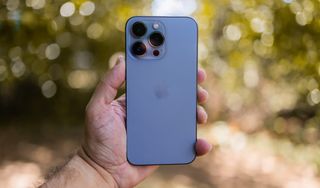Apple should put a color E Ink display on the iPhone 14 - because you would love it
A secondary color E Ink display makes perfect sense

Isn't it just like Apple to wait on an emerging technology until it gets good enough to meet the company's exacting standards? The company is, according to a new report from keen Apple Analyst at TF International Securities Ming-Chi Kuo, finally testing flexible color E Ink displays for future foldable devices.
We'll assume that these devices are future folding iPhones and future folding iPads. But why wait? Who wouldn't love a secondary screen on the back of the iPhone 14, which we think is coming in September or October of this year.
Before we dive into this, let's take another look at Kuo's rumor, which we also reported on here.
Apple is testing E Ink's Electronic Paper Display (EPD) for future foldable device's cover screen & tablet-like applications. The color EPD has the potential to become a mainstream solution for foldable devices' must-have cover/second screen thanks to its excellent power-saving.May 17, 2022
Color electronic ink displays, which work off reflective light, as opposed to backlighting, are not new. Companies like Qualcomm have been showing them off for well over a decade. But it's only recently that they've achieved color, refresh, and battery-life standards that might make them a viable alternative to, say, the flexible OLED screens favored by most folding-device manufacturers.
Yes, they make perfect sense for the outside of some flexi-iPhone or iPad, but they could also be a game-changer on the iPhone 14 (or iPhone 15).
I understand how carefully Apple protects its design IP; that iconic Apple logo has sat dead center on the back of virtually every iPhone since the 'Jesus' device of 2007. Nothing can come between Apple, the iPhone, and that logo.
And that's fine.
Get daily insight, inspiration and deals in your inbox
Get the hottest deals available in your inbox plus news, reviews, opinion, analysis and more from the TechRadar team.
But if you have an iPhone, take a look at the back. There's a solid two inches (or more if you have an iPhone 13 Pro Max) between the base of the logo and the bottom edge of the iPhone.
A color E Ink display would fit perfectly there – and if you think this is some flight of fancy, it's actually been done before, and on a larger scale.
Normally, a second screen, even an OLED one, might eat up too much precious battery life (yes, I know Samsung's Z Flip 3 also has a small secondary super-AMOLED screen on its back). However, there are a number of reasons why the new E Ink color screen might work perfectly on the iPhone 14.

A different screen
First up, it's reflective technology, which means you could see everything on it at a glance, without even waking the phone. I often keep my iPhone face-down on the table beside me, and many people do the same. With this second display, you could glance over and see a notification, or even – because it's color – a picture someone just shared with you.
Second, color E Ink is more power-efficient than LCD and even OLED. Instead of constantly refreshing to hold an image on the display, it can show it, and the E Ink will hold it until you touch the screen and open a different view. Also, E Ink's newest display runs in both color and black and white. In theory, an iPhone 14 owner could choose to run the external display on B&W mode to save even more power.
There would be obvious limits. E Ink still tops out at 300ppi, while the current iPhone 13 Super XDR Retina display boasts 460ppi. And its refresh rates are abysmal compared to OLED and LCD. It'll work for messages, still images, and alerts, but forget video and games.
There's no indication that Apple is testing color E Ink for the purpose of bringing a secondary display to the iPhone 14 – but wouldn't it be amazing if they did?

A 38-year industry veteran and award-winning journalist, Lance has covered technology since PCs were the size of suitcases and “on line” meant “waiting.” He’s a former Lifewire Editor-in-Chief, Mashable Editor-in-Chief, and, before that, Editor in Chief of PCMag.com and Senior Vice President of Content for Ziff Davis, Inc. He also wrote a popular, weekly tech column for Medium called The Upgrade.
Lance Ulanoff makes frequent appearances on national, international, and local news programs including Live with Kelly and Ryan, the Today Show, Good Morning America, CNBC, CNN, and the BBC.
Most Popular

